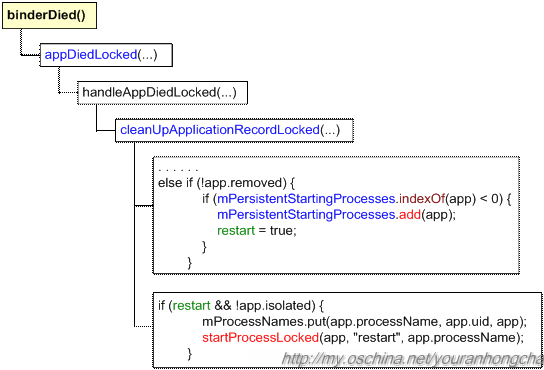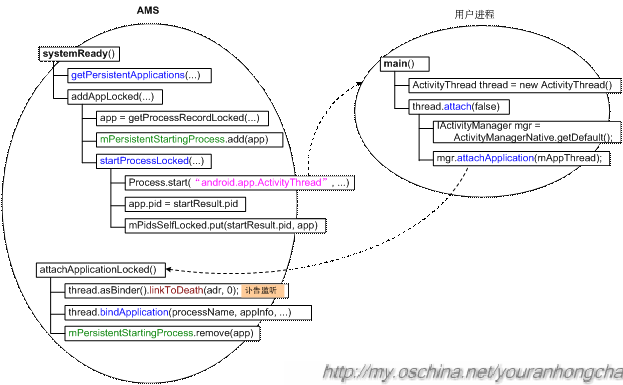1 启动persistent应用
在Android系统中,有一种永久性应用。它们对应的AndroidManifest.xml文件里,会将persistent属性设为true,比如:
|
1
2
3
4
|
<
application
android:name
=
"PhoneApp"
android:persistent
=
"true"
android:label
=
"@string/dialerIconLabel"
android:icon
=
"@drawable/ic_launcher_phone"
>
|
在系统启动之时,AMS的systemReady()会加载所有persistent为true的应用。
|
1
2
3
4
5
6
7
8
9
10
11
12
13
14
15
16
17
18
19
20
21
22
23
24
25
26
|
public
void
systemReady(
final
Runnable goingCallback)
{
. . . . . .
. . . . . .
try
{
List apps = AppGlobals.getPackageManager().
getPersistentApplications(STOCK_PM_FLAGS);
if
(apps !=
null
)
{
int
N = apps.size();
int
i;
for
(i=
0
; i<N; i++)
{
ApplicationInfo info = (ApplicationInfo)apps.get(i);
if
(info !=
null
&&
!info.packageName.equals(
"android"
))
{
addAppLocked(info,
false
);
}
}
}
}
catch
(RemoteException ex) {
// pm is in same process, this will never happen.
}
|
其中的STOCK_PM_FLAGS的定义如下:
|
1
2
|
// The flags that are set for all calls we make to the package manager.
static
final
int
STOCK_PM_FLAGS = PackageManager.GET_SHARED_LIBRARY_FILES;
|
上面代码中的getPersistentApplications()函数的定义如下:
|
1
2
3
4
5
6
7
8
9
10
11
12
13
14
15
16
17
18
19
20
21
22
23
24
25
26
27
28
|
public
List<ApplicationInfo> getPersistentApplications(
int
flags)
{
final
ArrayList<ApplicationInfo> finalList =
new
ArrayList<ApplicationInfo>();
// reader
synchronized
(mPackages)
{
final
Iterator<PackageParser.Package> i = mPackages.values().iterator();
final
int
userId = UserId.getCallingUserId();
while
(i.hasNext())
{
final
PackageParser.Package p = i.next();
if
(p.applicationInfo !=
null
&& (p.applicationInfo.flags & ApplicationInfo.FLAG_PERSISTENT) !=
0
&& (!mSafeMode || isSystemApp(p)))
{
PackageSetting ps = mSettings.mPackages.get(p.packageName);
finalList.add(PackageParser.generateApplicationInfo(p, flags,
ps !=
null
? ps.getStopped(userId) :
false
,
ps !=
null
? ps.getEnabled(userId) : COMPONENT_ENABLED_STATE_DEFAULT,
userId));
}
}
}
return
finalList;
}
|
从代码里可以看出,带persistent标志的系统应用(即flags中设置了FLAG_SYSTEM)是一定会被选上的,但如果不是系统应用的话,则要进一步判断当前是否处于“安全模式”,一旦处于安全模式,那么就算应用设置了persistent属性,也不会被选中。
随后systemReady()开始遍历选中的ApplicationInfo,并对包名不为“android”的结点执行addAppLocked()。addAppLocked()的代码如下:
|
1
2
3
4
5
6
7
8
9
10
11
12
13
14
15
16
17
18
19
20
21
22
23
24
25
26
27
28
29
30
31
32
33
34
35
36
37
38
39
40
|
final
ProcessRecord addAppLocked(ApplicationInfo info,
boolean
isolated)
{
ProcessRecord app;
if
(!isolated) {
app = getProcessRecordLocked(info.processName, info.uid);
}
else
{
app =
null
;
}
if
(app ==
null
) {
app = newProcessRecordLocked(
null
, info,
null
, isolated);
mProcessNames.put(info.processName, app.uid, app);
if
(isolated) {
mIsolatedProcesses.put(app.uid, app);
}
updateLruProcessLocked(app,
true
,
true
);
}
// This package really, really can not be stopped.
try
{
AppGlobals.getPackageManager().setPackageStoppedState(
info.packageName,
false
, UserId.getUserId(app.uid));
}
catch
(RemoteException e) {
}
catch
(IllegalArgumentException e) {
Slog.w(TAG,
"Failed trying to unstop package "
+ info.packageName +
": "
+ e);
}
if
((info.flags&(ApplicationInfo.FLAG_SYSTEM|ApplicationInfo.FLAG_PERSISTENT))
== (ApplicationInfo.FLAG_SYSTEM|ApplicationInfo.FLAG_PERSISTENT)) {
app.persistent =
true
;
app.maxAdj = ProcessList.PERSISTENT_PROC_ADJ;
}
if
(app.thread ==
null
&& mPersistentStartingProcesses.indexOf(app) <
0
) {
mPersistentStartingProcesses.add(app);
startProcessLocked(app,
"added application"
, app.processName);
}
return
app;
}
|
现在,我们就清楚了,那些persistent属性为true的应用,基本上都是在系统启动伊始就启动起来的。
因为启动进程的过程是异步的,所以我们需要一个缓冲列表(即上面代码中的mPersistentStartingProcesses列表)来记录那些“正处于启动状态,而又没有启动完毕的”ProcessRecord结点。一旦目标进程启动完毕后,目标进程会attach系统,于是走到AMS的attachApplicationLocked(),在这个函数里,会把目标进程对应的ProcessRecord结点从mPersistentStartingProcesses缓冲列表里删除。
|
1
2
3
4
5
6
7
8
9
10
11
12
13
14
15
16
17
18
19
20
21
22
23
|
private
final
boolean
attachApplicationLocked(IApplicationThread thread,
int
pid) {
// Find the application record that is being attached... either via
// the pid if we are running in multiple processes, or just pull the
// next app record if we are emulating process with anonymous threads.
ProcessRecord app;
. . . . . .
thread.asBinder().linkToDeath(adr,
0
);
. . . . . .
thread.bindApplication(processName, appInfo, providers,
app.instrumentationClass, profileFile, profileFd, profileAutoStop,
app.instrumentationArguments, app.instrumentationWatcher, testMode,
enableOpenGlTrace, isRestrictedBackupMode || !normalMode,
app.persistent,
new
Configuration(mConfiguration), app.compat,
getCommonServicesLocked(),
mCoreSettingsObserver.getCoreSettingsLocked());
. . . . . .
. . . . . .
// Remove this record from the list of starting applications.
mPersistentStartingProcesses.remove(app);
. . . . . .
|
2 如何保证应用的持久性(persistent)
我们知道,persistent一词的意思是“持久”,那么persistent应用的意思又是什么呢?简单地说,这种应用会顽固地运行于系统之中,从系统一启动,一直到系统关机。
为了保证这种持久性,persistent应用必须能够在异常出现时,自动重新启动。在Android里是这样实现的。每个ActivityThread中会有一个专门和AMS通信的binder实体——final ApplicationThread mAppThread。这个实体在AMS中对应的代理接口为IApplicationThread。
当AMS执行到attachApplicationLocked()时,会针对目标用户进程的IApplicationThread接口,注册一个binder讣告监听器,一旦日后用户进程意外挂掉,AMS就能在第一时间感知到,并采取相应的措施。如果AMS发现意外挂掉的应用是persistent的,它会尝试重新启动这个应用。
注册讣告监听器的代码如下:
|
1
2
3
|
AppDeathRecipient adr =
new
AppDeathRecipient(app, pid, thread);
thread.asBinder().linkToDeath(adr,
0
);
app.deathRecipient = adr;
|
其中的thread就是IApplicationThread代理。
AppDeathRecipient的定义如下:
|
1
2
3
4
5
6
7
8
9
10
11
12
13
14
15
16
17
18
19
20
21
22
23
24
25
26
27
28
|
private
final
class
AppDeathRecipient
implements
IBinder.DeathRecipient
{
final
ProcessRecord mApp;
final
int
mPid;
final
IApplicationThread mAppThread;
AppDeathRecipient(ProcessRecord app,
int
pid,
IApplicationThread thread)
{
if
(localLOGV)
Slog.v(TAG,
"New death recipient "
+
this
+
" for thread "
+ thread.asBinder());
mApp = app;
mPid = pid;
mAppThread = thread;
}
public
void
binderDied()
{
if
(localLOGV)
Slog.v(TAG,
"Death received in "
+
this
+
" for thread "
+ mAppThread.asBinder());
synchronized
(ActivityManagerService.
this
)
{
appDiedLocked(mApp, mPid, mAppThread);
}
}
}
|
当其监听的binder实体死亡时,系统会回调AppDeathRecipient的binderDied()。这个回调函数会辗转重启persistent应用,调用关系如下:
一般情况下,当一个应用进程挂掉后,AMS当然会清理掉其对应的ProcessRecord,这就是cleanUpApplicationRecordLocked()的主要工作。然而,对于persistent应用,cleanUpApplicationRecordLocked()会尝试再次启动对应的应用进程。代码截选如下:
|
1
2
3
4
5
6
7
8
9
10
11
12
13
14
15
16
17
18
19
20
21
22
23
24
25
26
27
28
29
30
31
32
33
|
private
final
void
cleanUpApplicationRecordLocked(ProcessRecord app,
boolean
restarting,
boolean
allowRestart,
int
index)
{
. . . . . .
. . . . . .
if
(!app.persistent || app.isolated)
{
. . . . . .
mProcessNames.remove(app.processName, app.uid);
mIsolatedProcesses.remove(app.uid);
. . . . . .
}
else
if
(!app.removed)
{
if
(mPersistentStartingProcesses.indexOf(app) <
0
) {
mPersistentStartingProcesses.add(app);
restart =
true
;
}
}
. . . . . .
. . . . . .
if
(restart && !app.isolated)
{
mProcessNames.put(app.processName, app.uid, app);
startProcessLocked(app,
"restart"
, app.processName);
}
else
if
(app.pid >
0
&& app.pid != MY_PID)
{
. . . . . .
}
. . . . . .
}
|
现在我们可以画一张关于“启动persistent应用”的示意图:
3 补充知识点
3.1 persistent应用可以在系统未准备好时启动
在AMS中,有一个isAllowedWhileBooting()函数,其代码如下:
|
1
2
3
4
|
boolean
isAllowedWhileBooting(ApplicationInfo ai)
{
return
(ai.flags & ApplicationInfo.FLAG_PERSISTENT) !=
0
;
}
|
从这个函数可以看到,将persistent属性设为true的应用,是允许在boot的过程中启动的。我们可以查看前文提到的startProcessLocked()函数:
|
1
2
3
4
5
6
7
8
9
10
11
12
13
14
15
16
17
18
19
20
21
22
23
24
25
26
27
28
29
30
31
32
33
34
35
|
final
ProcessRecord startProcessLocked(String processName,
ApplicationInfo info,
boolean
knownToBeDead,
int
intentFlags,
String hostingType, ComponentName hostingName,
boolean
allowWhileBooting,
boolean
isolated)
{
ProcessRecord app;
if
(!isolated)
{
app = getProcessRecordLocked(processName, info.uid);
}
else
{
// If this is an isolated process, it can't re-use an existing process.
app =
null
;
}
. . . . . .
. . . . . .
if
(!mProcessesReady
&& !isAllowedWhileBooting(info)
&& !allowWhileBooting) {
if
(!mProcessesOnHold.contains(app)) {
mProcessesOnHold.add(app);
}
if
(DEBUG_PROCESSES) Slog.v(TAG,
"System not ready, putting on hold: "
+ app);
return
app;
}
startProcessLocked(app, hostingType, hostingNameStr);
return
(app.pid !=
0
) ? app :
null
;
}
|
其中的最后几句可以改写为以下更易理解的形式:
|
1
2
3
4
5
6
7
8
9
10
|
if
(mProcessesReady || isAllowedWhileBooting(info) || allowWhileBooting)
{
startProcessLocked(app, hostingType, hostingNameStr);
return
(app.pid !=
0
) ? app :
null
;
}
else
{
. . . . . .
return
app;
}
|
也就是说,当系统已经处于以下几种情况时,多参数的startProcessLocked()会进一步调用另一个只有三个参数的startProcessLocked():
1)系统已经处于ready状态;
2)想要启动persistent应用;
3)参数中明确指定可以在boot过程中启动应用。
补充说一下,一般情况下,当AMS调用startProcessLocked()时,传入的allowWhileBooting参数都为false。比如说,当系统需要启动“某个content provider或者某个service或者某个特定activity”时,此时传给startProcessLocked()的allowWhileBooting参数是写死为false的。只有一种特殊情况下会在该参数中传入true,那就是当系统发出的广播intent中携带有Intent.FLAG_RECEIVER_BOOT_UPGRADE标记时,此时允许在系统未ready时,启动接受广播的目标进程。
4 结束
有关Android应用的persistent属性,我们就先说这么多。希望对大家有点儿帮助。























 2万+
2万+











 被折叠的 条评论
为什么被折叠?
被折叠的 条评论
为什么被折叠?








